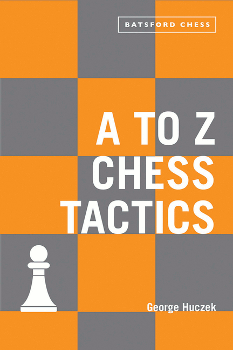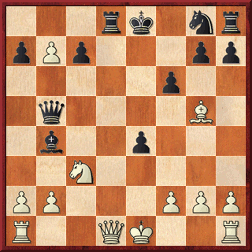A to Z Chess Tactics, George Huczek, Batsford, Paperback, ISBN: 9781849944465, 349pp., $19.95

George Huczek is a Canadian Correspondence Chess Association Senior Candidate Master and was on the Canadian Chess Federation Board of Governors. A to Z Chess Tactics is his first book. Here is how it is described on the back cover:
“An indispensable reference book of chess moves, perfect for any chess player, beginner or club player. A to Z Chess Tactics provides an explanation of all the key terms and jargon used in chess so you can understand them and put them into practice in your own game, from Castling to Zugzwang, from Underpromotion to Zwischenzug.
“Written in a clear and informative style, the book has a large section containing illustrative games from past chess masters and grandmasters that show the relevant chess definition in action. Plus there are exercises that illustrate each tactic – to test you on your growing ability. The exercises teach you how to seize the opportunities before they disappear as well as avoiding traps your opponent may leave.
“Useful for all chess players, this is an essential read for anyone looking to improve and understand the game better.”
While I like the book, the title offers a level of comprehensiveness that the contents do not quite fulfill and much of what I take issue with is the marketing promises rather than the contents. The cover pitches “Every chess move explained.” Yet, not every move is annotated. So to what exactly are they referring. Even stating every concept explained would be arguably inaccurate.
The book is divided into fifty-six sections, with fifty devoted to the tactical themes in alphabetical order. There is also an introduction, two theme indices, a section of 400 tactical exercises for solving, and the solutions. It is between the exercises and the solutions that they chose to include the evaluation symbols (on page 311), which is an odd placement when presumably knowledge of what the symbols mean would be important enough to list at the very beginning. There is no player index.
The back cover blurb promises “illustrative games,” but there are very few complete games in the book. Game positions or game fragments is correct. Granted, this may be a semantic complaint, but let’s describe the contents correctly.
One of the few full games given is in the introduction. A to Z Chess Tactics begins with a look at one of the deepest and most spectacular combinations in chess history. Namely, that of Kasparov-Topalov, Wijk aan Zee, 1999, which kicks off with the brilliant 24.Rxd4. The full game is given with easy to follow commentary. The author calls the sacrifice “speculative”; however, it was nothing of the sort. According to Kasparov, he had analyzed the acceptance of the sacrifice to its conclusion eighteen moves later, and was aware that the response 24…Kb6 was a draw. No speculation, just raw calculation.
Huczek notes that “[s]ome of the tactical motifs that occurred or might have arisen in this game included pawn storms, prophylaxis, a central pawn break, checking the king, vacating a square, opening the centre, piece development, gain of tempo, rook sacrifice, clearance sacrifice, infiltration, weaknesses on the flank, knight sacrifice, hunting the king, jostling the king, perpetual check, maintaining the initiative, pawn sacrifice, overloading, simplification, hanging pieces, forced moves, skewers, pins, mating attacks and blockades.”
Yet, of the twenty-six motifs listed in this paragraph only fourteen are included in the table of contents; twenty-one are listed in the general index; and fourteen are included in the theme index. Five of the motifs are not featured in any of these sections.
To achieve the “A to Z” scheme some liberties were taken. For instance, fortress becomes “Establishing a Fortress,” an attack on the king becomes “Jostling the King,” zugzwang becomes “Yielding to Zugzwang,” and a trapped piece is under the headings “No Retreat” and “Queen Ambush.” Though the latter is also defined in a broader sense as we will see below.
Jostling the king sounded to me like a king hunt, but Huczek defines them separately. “Jostling the king by some means or another,” he writes, “disrupts the king’s defences and can lead to further vulnerabilities or even a quick checkmate. This is usually achieved by a sacrifice. Once the king’s fortress has been breached, it may be very difficult for the defender to reorganise and recover in time.”
Huczek defines “hunting the king” as “[w]hen the opponent’s king is exposed it can be subjected to a series of checks in a king hunt, where it will be forced to move around the board in an effort to find a safe haven. Sometimes the king will even be drawn across the board into enemy territory. The attacking side will try to maintain the initiative, checking the king and aiming for checkmate. When forcing moves can be employed, follow up replies can be worked out in advance.”
I also question whether “swindle” should be included as a stand-alone tactic. Nevertheless, these objections do not take away from the enjoyment of the book. I like puzzle books in general. I like and recommend A to Z Chess Tactics. Any player can benefit from working through it and it is a delight to delve into, whether at random or methodically slogging through from beginning to end.
Let’s take a look at two examples:
Castling
“Here is an example from the correspondence game Gurvich-Pampin, played in 1976.
“White’s knight is pinned, the bishop is hanging and the queen attacked by the rook. There is an advanced passed pawn on the b-file but this does not seem to present any real danger.
“At first glance it appears that here White’s game is on the verge of collapse.

“However, Black’s queen would be in jeopardy if it were not for the pin on the knight. White is able to exploit this circumstance and gain a decisive advantage with a tactic involving castling.
1 Qxd8+ Kxd8
“Black’s king has been diverted to the open d-file. If Black had tried 1…Kf7 instead. Then the pawn, which seemed only a moment ago to have no future, would be able to promote on the b-file by 2 b8Q. At this critical moment White is able to gain an important tempo, break the pin, and secure the king by castling queenside.
2 0-0-0+

“Now White’s knight is no longer pinned and therefore Black’s king and queen are simultaneously under attack. Black has no satisfactory way of dealing with both these threats.
2…Ke7
“No better is 2…Qd7 3 b8Q+ Ke7 4 Qxb4+ Ke8 5 Rxd7 and Black will soon be mated.”
3 Nxb5 1-0
Here is an example from the exercises section:

White to move
Thuesen – Horst, Copenhagen 1990. 1 Qe8+ Rxe8 2 Rxe8+ Bc8 3 Ng5+ [The queen ambush – MD] 3…Kb8 4 Nxh7 1-0 Although two trusted database sources have the finish as 3…Qb7 4 Rxc8#.
Thanks for the review. It helped me make a decision not to buy this book. I have numerous books of this type — everything from Nunn’s “Learn Chess Tactics” to Neishtadt’s “Improve Your Chess Tactics” to Averbakh’s “Chess Tactics for Advanced Players,” all excellent — and don’t need another.